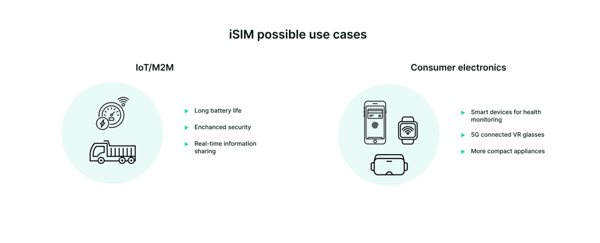In general, we can say that the SIM card market has been staying the same for the last 30 years. The last new form factor of a solderable chip (MFF2) was introduced in 2010. But, what has changed, is the technology behind the SIM cards.
Hardware-based eSIM (eUICC) has been the most talked about SIM technology over the last few years, introducing switching carrier profiles over the air without actually having to remove the card. Yet today, after a long and bumpy adoption period, we can start talking about the usage of eSIM becoming mainstream.
The Global eSIM market is expected to reach $7.14 billion by 2025, a Compound Annual Growth Rate of 36.5% from 2019 to 2025, according to a new report from Allied Market Research. As market demand is driving operators and device manufacturers to support the eSIM, many in the industry are looking for smaller form factors and greater integration to deliver new business opportunities.
This is where software integrated iSIM (iUICC) enters the game. Since we last covered the topic, an iSIM has been announced to be compliant with the GSMA specifications, and is promised to bring a vast change into the cellular industry – for both consumer and IoT devices. According to Counterpoint Research, iSIM capable devices’ growth is expected to outstrip eSIM devices’ growth over the next five years.
Why should we care about iSIM today? And how does an iSIM add value to an eSIM? – These are the questions we aim to answer today.
What is an iSIM and how does it compare to eSIM?
The term iSIM (iUICC) stands for integrated SIM. This means that the standalone physical SIM chip in the form of 4FF, 3FF, 2FF or MFF2 is not needed anymore. It is now integrated with the processor core and using the encryption of SoC (System on a Chip), on a cellular module. You can think of an iSIM as a miniaturised SIM card integrated within the SoC, which becomes its operational system. The iSIM complies with the GSMA’s eSIM and RSP specifications.
Even though iSIM has many of the same benefits as eSIM, the main difference comes in hardware. It has moved eSIM’s functionality into a device’s hardware chipset, so the separate processor is not needed anymore. That leaves more space for the device’s own components and benefits its power consumption. Hardware manufacturers and processor design companies claim to be able to implement the SoC architectures that integrate the SIM functionality, with an existing onboard processor and cellular modem.
ARM, a well-known semiconductor company, is pushing forward the iSIM, with their chipset design used in many cellular modems. Their idea of putting the SIM inside the same chipset has its advantages and seems reasonable.
According to the recent press release, the big names in the telecommunications industry, Vodafone, Qualcomm Technologies, Inc., and Thales, are leading the way of implementing iSIM technology in consumer smartphones.What are the benefits of iSIM?
One of the main improvements of iSIM is considered security. As it’s completely integrated into the device, an iSIM can’t be removed or used in multiple devices, thus making it more difficult to steal or tamper with. iSIM form factor is based on TRE (Tamper Resistant Elements), providing the most reliable end-to-end security – this ensures that the connectivity between the device and cellular network is secure. It’s also capable of securely hosting eSIM operational profiles together with applications and their confidential data.
Another security benefit of iSIM has to do with the introduction of 5G in the cellular connectivity market. In 2G, 3G and 4G network technologies, the subscriber identifier (IMSI) was sent to mobile network operators (MNOs) without the information being encrypted, then the latest 5G standards enable MNOs to encrypt that info before it is sent OTA. The encryption can happen either on the device or on 5G SIM, eSIM or iSIM.
Over the years, SIM form factors have gone increasingly smaller to support the market demand and new use cases. iSIM is significantly smaller than its predecessor MFF2 form factor embedded SIM, as it’s built directly into the device’s chipset instead of using separate hardware. The reduction of components, which previously made the devices costly to build, may also reduce the device’s power consumption and increase it’s battery life.
What are the risks?
Even though now in 2022 the iSIM technology has been certified by GSMA, it’s still lacking the test of a large scale deployment, thus the improved security might not be exactly as good as it’s claimed. As much as having the user's identity held on the hardware itself is a bonus, it’s also a risk. If someone should get their hands on the hardware and remove it, it would be considered a significant threat to the device’s security.
Although some MNOs and hardware manufacturers have already highly invested in an iSIM solution, it really needs mass market adoption to succeed. As of right now, we also have limited knowledge on how the technology works with MVNOs (Mobile Virtual Network Operators) and how interoperability plays a role in the system.
Conclusion
At 1oT, we firmly believe that the changes in SIM technology can’t be ignored, as they are paving the road for the IoT deployments of the future.
We believe that once it reaches its maturity stage, iSIM will benefit the IoT (and consumer electronics) sector greatly. But, considering how much time it took for eSIM to build up, it still may be years from now.
Until then, eSIM stays as a tried, tested and trustworthy option for your IoT deployments.
If you have more questions about 1oT eSIM or are wondering which SIM type to choose, don’t hesitate to contact us at sales@1ot.com.





